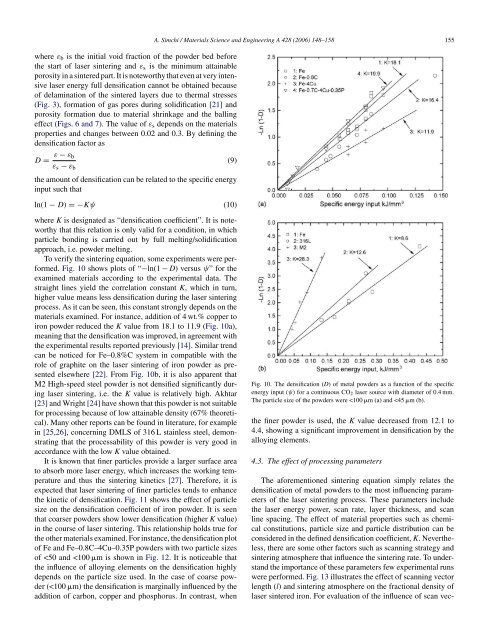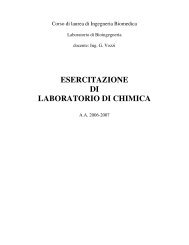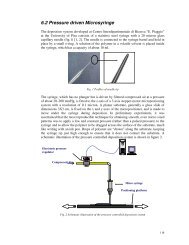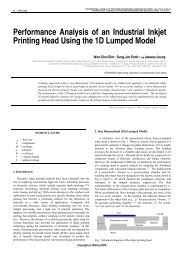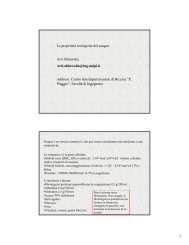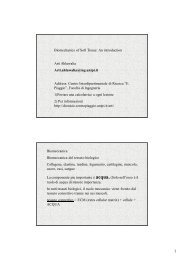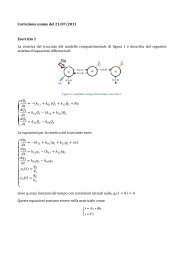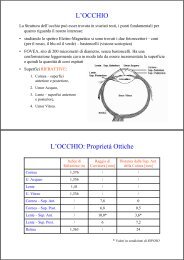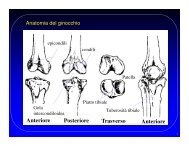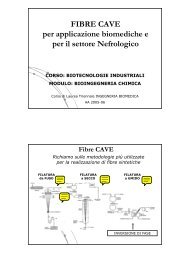Direct laser sintering of metal powders: Mechanism, kinetics and ...
Direct laser sintering of metal powders: Mechanism, kinetics and ...
Direct laser sintering of metal powders: Mechanism, kinetics and ...
- No tags were found...
You also want an ePaper? Increase the reach of your titles
YUMPU automatically turns print PDFs into web optimized ePapers that Google loves.
where ε b is the initial void fraction <strong>of</strong> the powder bed beforethe start <strong>of</strong> <strong>laser</strong> <strong>sintering</strong> <strong>and</strong> ε s is the minimum attainableporosity in a sintered part. It is noteworthy that even at very intensive<strong>laser</strong> energy full densification cannot be obtained because<strong>of</strong> delamination <strong>of</strong> the sintered layers due to thermal stresses(Fig. 3), formation <strong>of</strong> gas pores during solidification [21] <strong>and</strong>porosity formation due to material shrinkage <strong>and</strong> the ballingeffect (Figs. 6 <strong>and</strong> 7). The value <strong>of</strong> ε s depends on the materialsproperties <strong>and</strong> changes between 0.02 <strong>and</strong> 0.3. By defining thedensification factor asD = ε − ε b(9)ε s − ε bthe amount <strong>of</strong> densification can be related to the specific energyinput such thatln(1 − D) =−Kψ (10)A. Simchi / Materials Science <strong>and</strong> Engineering A 428 (2006) 148–158 155where K is designated as “densification coefficient”. It is noteworthythat this relation is only valid for a condition, in whichparticle bonding is carried out by full melting/solidificationapproach, i.e. powder melting.To verify the <strong>sintering</strong> equation, some experiments were performed.Fig. 10 shows plots <strong>of</strong> “−ln(1 − D) versus ψ” for theexamined materials according to the experimental data. Thestraight lines yield the correlation constant K, which in turn,higher value means less densification during the <strong>laser</strong> <strong>sintering</strong>process. As it can be seen, this constant strongly depends on thematerials examined. For instance, addition <strong>of</strong> 4 wt.% copper toiron powder reduced the K value from 18.1 to 11.9 (Fig. 10a),meaning that the densification was improved, in agreement withthe experimental results reported previously [14]. Similar trendcan be noticed for Fe–0.8%C system in compatible with therole <strong>of</strong> graphite on the <strong>laser</strong> <strong>sintering</strong> <strong>of</strong> iron powder as presentedelsewhere [22]. From Fig. 10b, it is also apparent thatM2 High-speed steel powder is not densified significantly during<strong>laser</strong> <strong>sintering</strong>, i.e. the K value is relatively high. Akhtar[23] <strong>and</strong> Wright [24] have shown that this powder is not suitablefor processing because <strong>of</strong> low attainable density (67% theoretical).Many other reports can be found in literature, for examplein [25,26], concerning DMLS <strong>of</strong> 316 L stainless steel, demonstratingthat the processability <strong>of</strong> this powder is very good inaccordance with the low K value obtained.It is known that finer particles provide a larger surface areato absorb more <strong>laser</strong> energy, which increases the working temperature<strong>and</strong> thus the <strong>sintering</strong> <strong>kinetics</strong> [27]. Therefore, it isexpected that <strong>laser</strong> <strong>sintering</strong> <strong>of</strong> finer particles tends to enhancethe kinetic <strong>of</strong> densification. Fig. 11 shows the effect <strong>of</strong> particlesize on the densification coefficient <strong>of</strong> iron powder. It is seenthat coarser <strong>powders</strong> show lower densification (higher K value)in the course <strong>of</strong> <strong>laser</strong> <strong>sintering</strong>. This relationship holds true forthe other materials examined. For instance, the densification plot<strong>of</strong> Fe <strong>and</strong> Fe–0.8C–4Cu–0.35P <strong>powders</strong> with two particle sizes<strong>of</strong>


